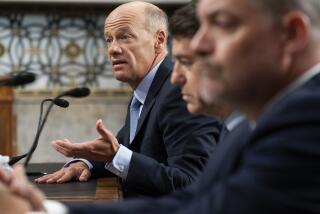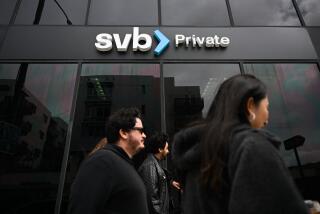Citigroup and 3 other banks fail Fed stress test
- Share via
Reporting from Washington, Los Angeles and New — More than three years after getting lifesaving injections of federal cash, the nation’s major banks are generally healthy enough to withstand another economic shock.
That’s the assessment from the latest round of stress tests on the 19 biggest banks by the Federal Reserve. But there are still some signs the industry hasn’t fully healed from Wall Street’s huge meltdown.
Four banking firms, including giant Citigroup Inc., failed one or more tests on whether they would survive a worst-case scenario. The Fed’s stress test gave passing grades to 15 of the nation’s top banks that have improved their finances.
Citigroup, however, didn’t fail by much; it said it would revise its capital plan to meet the requirements.
Other banks that did not pass the central bank’s examination were Ally Financial Inc. and SunTrust Banks Inc.; MetLife Inc., which didn’t take any bailout money, also failed.
The Fed’s stress tests for America’s biggest banks began in 2009 after the government bailed out the banking industry after Lehman Bros. collapsed.
This time, the examination tested how banks would fare in another economic catastrophe that included unemployment soaring to 13%, a 50% drop in the Dow Jones industrial average and a 21% crash in housing values.
Analysts said the good news is that the banking industry continues to make strides. Three years ago, 10 of the banks failed and were ordered by the Fed to raise their capital reserves by a combined $75 billion.
The results of the latest test aren’t likely to lead to any orders to raise capital. The Fed, instead, will not allow them to increase dividends or buy back additional stock — much to the disappointment of shareholders.
Citigroup’s test brought into question the future of Chief Executive Vikram Pandit, especially as the Fed reported larger-than-expected loan loss projections at a bank that nearly toppled during the financial crisis.
“The buzz among analysts is what this means for the future of Vikram,” said Nancy Bush, a bank analyst with SNL Financial. “Is he going to be out of a job?”
Under the stress test scenario, the bank would lose $67 billion on loans, representing 11.2% of its loan portfolio. Of the 19 largest banks, only Capital One Financial Corp. had a higher rate, 11.4%, of loan losses.
Citigroup, one of the hardest hit by the financial crisis, had indicated that it had brought its problems more under control. Pandit has said repeatedly that Citi would be able to return capital to shareholders by increasing its dividend, now in the basement at a penny per share per quarter, or by buying back its shares.
On Tuesday, Citigroup said the Fed had blocked those plans because of the stress test results. The company noted that it had failed the stress test only when those plans were included in the model, and said that it is “one of the best capitalized large banks in the world.”
Still, Citigroup’s projected losses on first mortgages were much higher than those of Bank of America, which despite highly publicized problems at its Countrywide Financial unit was barely above the median of the largest banks in projected mortgage losses.
Citigroup’s stock is likely to be hit the hardest by the central bank’s findings. Shares rose $2.16, or 6.3%, to $36.45 in regular trading Tuesday before the Fed released its results, then tumbled in after-hours trading.
For many analysts the most encouraging results came from Bank of America, which has struggled to convince investors of its viability over the last few years as it has been hit by big losses on its mortgage portfolios.
BofA was even with its rivals Wells Fargo and JPMorgan Chase in overall projected loan losses, all of them just above the median for the large banks that were tested. Bank of America has not proposed giving any capital back to shareholders, so the results won’t provide any immediate gratification for investors, but the bank will now be in a better position moving forward.
Erik Oja, a bank analyst at Standard & Poor’s, said this test was much tougher than the one in 2009 and another in 2011.
“This was a much more severe scenario,” Oja said.
Although the scenario seems extreme — the 13% unemployment rate would top the post-World War II high of 10.8% in 1982 — it’s not a stretch given the increasing tensions over Iran that have caused gasoline prices to soar. For example, the Dow lost more than half its value from late 2007 to early 2009.
Under the Fed’s scenario, losses at the 19 largest banks would total $534 billion.
Many of the banks that passed the stress tests are likely to move ahead with plans to return capital to investors. That may provide another bump to bank stocks and to the larger market on Wednesday.
JPMorgan Chase announced earlier Tuesday that it had been given permission to raise its dividend to 30 cents from 25 cents and to buy back $15 billion worth of shares in the company. The bank’s stock shot up $2.85, or 7%, to $43.39.
More to Read
Inside the business of entertainment
The Wide Shot brings you news, analysis and insights on everything from streaming wars to production — and what it all means for the future.
You may occasionally receive promotional content from the Los Angeles Times.












